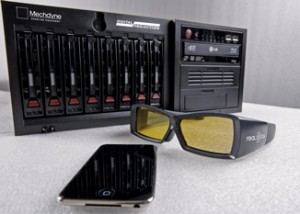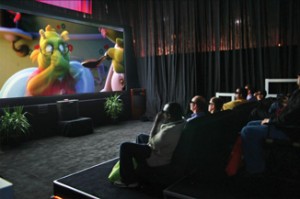Wiring a Venue to Support 3D Source and Display Connectivity
It’s time once again to ask that age old question: “How do I plan for the future without a Crystal Ball?” Most everyone has been teased with quality 3D by means of the runaway 3D hit Avatar, and some have seen killer demonstrations of 3D on flat panels or via the state-of-the-art performance of DP’s TITAN 1080p 3D, but how do we prepare our clients for the future of 3D? More importantly, how do we pre-wire current and future projects to ensure our installations are fully 3D capable? As always, the best way to prepare for the future is to learn from the past and research the present.
 To begin, let’s look at what we’ve learned from the past, starting with HDMI 1.1. The first cables and devices left us all with enough headaches to keep Advil in business for another 50 years. We found digital, unlike analog, very unforgiving. You either have an excellent picture, or you have nothing. And “nothing” means no easy means of troubleshooting. Additionally, we’ve learned that the best time to pull cable is before drywall is up and the job is finished.
To begin, let’s look at what we’ve learned from the past, starting with HDMI 1.1. The first cables and devices left us all with enough headaches to keep Advil in business for another 50 years. We found digital, unlike analog, very unforgiving. You either have an excellent picture, or you have nothing. And “nothing” means no easy means of troubleshooting. Additionally, we’ve learned that the best time to pull cable is before drywall is up and the job is finished.
Attempting to snake long HDMI or DVI cables through existing conduit or through finished walls and ceilings is a thankless and difficult task. Finally, let’s remember that there is always a company that will build a black box that accepts one format and converts to another.
Now, let’s look at what we know from the present. First, HDMI 1.2, 1.3, and DVI are all compatible. The current 120 Hz, full 1080p 3D capable graphics cards found in servers output either 2 x single-link DVI (commonly referred to as “Dual Pipe”), 2 xHDMI 1.3, or a single dual-link DVI cable. In all of these cases you can find discrete left and right eye information, a data line, and a clock within the multi-wire cables. Current Stereoscopic players used on media servers actually play two files simultaneously, one for the left eye and one for the right eye. Each file is a full 1080p 60Hz. So, to plan for the maximum bandwidth scenario, we need enough signal distribution bandwidth to carry 2 x 1080p 60Hz signals from the source rack to the projector.
In addition, active 3D systems, which represent the highest quality 3D available, require the left eye / right eye sync signal to be distributed to the projector, and broadcast to the active 3D glasses via an IR emitter. Since the left eye / right eye sync is a simple square wave, it is low bandwidth and a single BNC cable will suffice.
 Considering the above, let’s detail the 3D signal distribution you should plan to install for all of your DP 3D projector installations. First, the 3D signal will undoubtedly be digital. The digital packet will be something less than 2x the current HDMI 1.3 standard. There are many reliable HDMI 1.3, single-link and dual-link DVI cables available from a variety of manufacturers, and we all have our favorite trusted brands. To support the highest quality 3D sources and displays, in addition to the BNC cable for the left eye / right eye sync, we suggest you pull one of the following cable sets from the source rack to the projector:
Considering the above, let’s detail the 3D signal distribution you should plan to install for all of your DP 3D projector installations. First, the 3D signal will undoubtedly be digital. The digital packet will be something less than 2x the current HDMI 1.3 standard. There are many reliable HDMI 1.3, single-link and dual-link DVI cables available from a variety of manufacturers, and we all have our favorite trusted brands. To support the highest quality 3D sources and displays, in addition to the BNC cable for the left eye / right eye sync, we suggest you pull one of the following cable sets from the source rack to the projector:
-
- 2 x HDMI 1.3 cables. It is a good idea to pull a 3rd as well, to support troubleshooting and to assure you have a backup should one of the first two cables fail.
- 2 x single-link DVI cables. Again, it is a good idea to pull a 3rd, to support troubleshooting and to assure you have a backup should one of the first two cables fail.
- 1 x dual-link DVI cable (and yes, again we recommend you pull a spare to support troubleshooting and to assure you have a backup should one of the first two cables fail). Please note, the dual-link DVI standard can accommodate both the left eye and right eye 1080p signals via two wires contained within the single cable, so you are pulling less cable, however the cost of dual-link DVI cables and distribution hardware is significantly more expensive than distributing via single-link DVI or HDMI 1.3.
If you use a pair of HDMI 1.3 cables or a pair of single-link DVI cables and you experience any difficulty displaying the 3D signal, for troubleshooting purposes, you can always use a standard 2D 1080p source (60 Hz), such as a Blu-ray player, to test each of the cables to confirm bandwidth performance. If both of the HDMI 1.3 or single-link DVI cables work properly on a standard 60 Hz 1080p signal, there will absolutely support the 3D signals.
A bit more information: Consumer 3D standards are still emerging, and at this point, it looks like the long-term 3D signal distribution solution may beHDMI 1.4. Like dual-link DVI, a single HDMI 1.4 cable will carry both the left eye and right eye components of a 3D 1080p signal. If and when theHDMI 1.4 standard finally emerges in consumer products, there will certainly be companies like EXTRON or GEFEN that will provide simple boxes to convert HDMI 1.4 to and from 2 x HDMI 1.3, 2 x single-link DVI cables, or dual-link DVI.
Unfortunately, HDMI 1.4 is not an established standard yet, and no HDMI 1.4 cables or distribution hardware exist in the market at this point. Meanwhile, we all have 3D installations to complete! By taking the signal distribution approach we describe above, which is based on well established technologies and standards, you can accommodate the long-term bandwidth requirements of 3D content while still proceeding with installations today. If and when HDMI 1.4 becomes established as a standard and available in products, we recommend that our customers should NOT immediately start pulling HDMI 1.4 cables instead of the options referenced above. Given the initial problems with HDMI and HDCP, which were pretty costly to many integrators, we believe it would be wise to wait until there is certainty that all of the bugs have been worked out of HDMI 1.4.
Also worth noting, HDMI 1.3 and single link DVI cables are likely to be a fraction of the cost of the first generation HDMI 1.4 cables (when they finally come out). Running 120 Hz 3D sources via this established “Dual Pipe” format keeps each individual signal at 60Hz, and over long cables runs, this will help keep materials costs low while assuring all of the distribution bandwidth 3D requires. As is always the case with copper HDMI 1.3 and DVI cables, use high quality cables and be very cautious about runs over 50 feet. Installations requiring runs beyond 50’ should employ fiber-optic cables.
As an alternative, high speed data line like CAT 6 may also be employed to provide added bandwidth and connectivity. Once again, look at all of the black boxes available that convert source format “A” to CAT 6, distribute via CAT 6, and then convert back to format “A”. The above recommended cabling approach will provide excellent signal distribution, capable of supporting today’s state of the art graphics and media cards, as well as the diversity of 120 Hz 1080p 3D content and sources that lie in our future.
For more information on HDMI-1.4, its support for 3D media, and the likely timing of its roll-out, click here to read a recent interview with HDMI Licensing President Steve Venuti.


